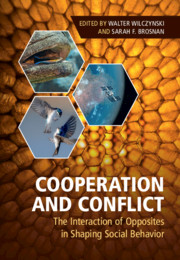Book contents
- Cooperation and Conflict
- Cooperation and Conflict
- Copyright page
- Dedication
- Contents
- Contributors
- Acknowledgments
- Introduction
- Part I Broad Insights from Political Science to Molecular Behavior
- Part II Neural Mechanisms
- Part III Species Comparisons
- 8 Understanding the Trade-off between Cooperation and Conflict in Avian Societies
- 9 Cooperation and Conflict in Mutualisms with a Special Emphasis on Marine Cleaning Interactions
- 10 The Fundamental Role of Aggression and Conflict in the Evolution and Organization of Social Groups
- Index
- References
10 - The Fundamental Role of Aggression and Conflict in the Evolution and Organization of Social Groups
from Part III - Species Comparisons
Published online by Cambridge University Press: 08 February 2021
- Cooperation and Conflict
- Cooperation and Conflict
- Copyright page
- Dedication
- Contents
- Contributors
- Acknowledgments
- Introduction
- Part I Broad Insights from Political Science to Molecular Behavior
- Part II Neural Mechanisms
- Part III Species Comparisons
- 8 Understanding the Trade-off between Cooperation and Conflict in Avian Societies
- 9 Cooperation and Conflict in Mutualisms with a Special Emphasis on Marine Cleaning Interactions
- 10 The Fundamental Role of Aggression and Conflict in the Evolution and Organization of Social Groups
- Index
- References
Summary
Research on the evolution of social groups has focused substantially on processes that increase cooperative behaviors (Bourke, 2011). Indeed, each major evolutionary transition (the evolution of eukaryotes from prokaryotes, the evolution of multicellular organisms from single-celled organisms, the evolution of eusocial insect societies from solitary species, etc.) involves increasing cooperative behavior to the point where previously independent units now must interact to successfully replicate (Szathmary and Smith, 1995). With the focus on cooperation, the importance of aggression and conflict in societies is typically overlooked, despite the fundamental nature of these processes in giving rise to and maintaining social structures (see Chapters 2, 8, and 9 for other examples). For instance, maternal antipredator aggression is the critical antecedent to a stable social unit that exists in a central place (e.g., a nest or burrow) (Brunton, 1990; Groom, 1992). Within social groups, aggression among individuals establishes dominance hierarchies, manages conflict, and leads to division of labor in contexts of reproduction and offspring care (Ratnieks et al., 2006; Wittemyer and Getz, 2007). Here we discuss the possible roles of aggression and conflict in the evolution and organization of social groups, and explore the underlying molecular and physiological mechanisms associated with these drivers of sociality. We define aggression as behaviors that carry a potential physical cost or otherwise could reduce the direct fitness of the individuals involved, and we define conflict as situations in which the fitness interests of interacting individuals diverge, regardless of the behavioral outcome.
- Type
- Chapter
- Information
- Cooperation and ConflictThe Interaction of Opposites in Shaping Social Behavior, pp. 212 - 233Publisher: Cambridge University PressPrint publication year: 2021
References
- 2
- Cited by

